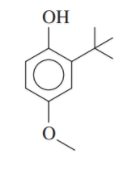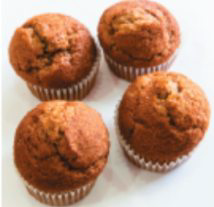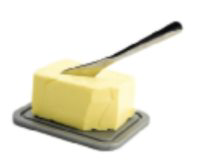
Basic Chemistry
6th Edition
ISBN: 9780134878119
Author: Timberlake, Karen C. , William
Publisher: Pearson,
expand_more
expand_more
format_list_bulleted
Concept explainers
Textbook Question
Chapter 17, Problem 86APP
Classify each of the following according to its
- BHA is an antioxidant used as a preservative in foods such as baked goods, butter, meats, and snack foods.
 |
 Baked goods contain BHA as a preservative. |
 |
 Butter |
Expert Solution & Answer
Want to see the full answer?
Check out a sample textbook solution
Students have asked these similar questions
Identify the most acidic proton in the compound:
a
d
b
Оа
Ob
Ос
○ d
A Standard Reference Material is certified to contain 94.6 ppm of an organic contaminant in soil. Your analysis gives values of 98.6, 98.4, 97.2, 94.6, and 96.2. Do your results differ from the expected results at the 95% confidence interval?
The percentage of an additive in gasoline was measured six times with the following results: 0.13, 0.12, 0.16, 0.17, 0.20, and 0.11%. Find the 95% confidence interval for the percentage of additive.
Chapter 17 Solutions
Basic Chemistry
Ch. 17.1 - Prob. 1PPCh. 17.1 - Prob. 2PPCh. 17.1 - Prob. 3PPCh. 17.1 - Prob. 4PPCh. 17.1 - Prob. 5PPCh. 17.1 - Prob. 6PPCh. 17.1 - Prob. 7PPCh. 17.1 - Prob. 8PPCh. 17.1 - Prob. 9PPCh. 17.1 - Prob. 10PP
Ch. 17.1 - Prob. 11PPCh. 17.1 - Draw the condensed structural formula for each of...Ch. 17.1 - Prob. 13PPCh. 17.1 - Prob. 14PPCh. 17.1 - Prob. 15PPCh. 17.1 - Prob. 16PPCh. 17.1 - Prob. 17PPCh. 17.1 - Prob. 18PPCh. 17.2 - Prob. 19PPCh. 17.2 - Identify each of the following as an alkane,...Ch. 17.2 - Prob. 21PPCh. 17.2 - Prob. 22PPCh. 17.2 - Prob. 23PPCh. 17.2 - Prob. 24PPCh. 17.2 - Draw the condensed structural formula for the...Ch. 17.2 - Prob. 26PPCh. 17.2 - Prob. 27PPCh. 17.2 - Prob. 28PPCh. 17.2 - Prob. 29PPCh. 17.2 - Prob. 30PPCh. 17.2 - Prob. 31PPCh. 17.2 - Prob. 32PPCh. 17.3 - Prob. 33PPCh. 17.3 - Prob. 34PPCh. 17.3 - Prob. 35PPCh. 17.3 - Draw the line-angle formula for each of the...Ch. 17.4 - Prob. 37PPCh. 17.4 - Prob. 38PPCh. 17.4 - Prob. 39PPCh. 17.4 - Write the common name for each of the following:...Ch. 17.4 - Draw the condensed structural and line-angle...Ch. 17.4 - Draw the condensed structural and line-angle...Ch. 17.5 - Write the common name for each of the following:Ch. 17.5 - Write the common name for each of the following:Ch. 17.5 - Prob. 45PPCh. 17.5 - Prob. 46PPCh. 17.5 - Prob. 47PPCh. 17.5 - Draw the condensed structural formula for a and b...Ch. 17.6 - Prob. 49PPCh. 17.6 - Write the IUPAC and common name (if any) for each...Ch. 17.6 - Prob. 51PPCh. 17.6 - Prob. 52PPCh. 17.6 - Prob. 53PPCh. 17.6 - Prob. 54PPCh. 17.6 - Prob. 55PPCh. 17.6 - Prob. 56PPCh. 17.6 - Prob. 57PPCh. 17.6 - Write the IUPAC and common names, if any, for each...Ch. 17.6 - Draw the condensed structural formulas for a and b...Ch. 17.6 - Draw the condensed structural formulas for a and b...Ch. 17.7 - Write the common name for each of the following:...Ch. 17.7 - Prob. 62PPCh. 17.7 - Prob. 63PPCh. 17.7 - Prob. 64PPCh. 17.7 - Prob. 65PPCh. 17.7 - Prob. 66PPCh. 17.7 - Prob. 67PPCh. 17.7 - Prob. 68PPCh. 17.7 - Prob. 69PPCh. 17.7 - Prob. 70PPCh. 17.7 - Prob. 71PPCh. 17.7 - Prob. 72PPCh. 17 - The chapter sections to review are shown in...Ch. 17 - The chapter sections to review are shown in...Ch. 17 - Prob. 75UTCCh. 17 - Prob. 76UTCCh. 17 - Prob. 77APPCh. 17 - Prob. 78APPCh. 17 - Prob. 79APPCh. 17 - Prob. 80APPCh. 17 - Prob. 81APPCh. 17 - Prob. 82APPCh. 17 - Prob. 83APPCh. 17 - Prob. 84APPCh. 17 - Classify each of the following according to its...Ch. 17 - Classify each of the following according to its...Ch. 17 - Name each of the following aromatic compounds:...Ch. 17 - Prob. 88APPCh. 17 - Prob. 89APPCh. 17 - Draw the structural formula for each of the...Ch. 17 - Prob. 91APPCh. 17 - Prob. 92APPCh. 17 - Draw the condensed structural formula for each of...Ch. 17 - Draw the condensed structural formula for each of...Ch. 17 - Write the IUPAC name for each of the following:...Ch. 17 - Write the IUPAC name for each of the following:...Ch. 17 - Draw the condensed structural formulas for a and b...Ch. 17 - Prob. 98APPCh. 17 - Prob. 99APPCh. 17 - Prob. 100APPCh. 17 - Prob. 101APPCh. 17 - Draw the condensed structural formula for each of...Ch. 17 - Prob. 103APPCh. 17 - Prob. 104APPCh. 17 - Prob. 105CPCh. 17 - Prob. 106CPCh. 17 - The following problems are related to the topics...Ch. 17 - Prob. 108CPCh. 17 - The following problems are related to the topics...Ch. 17 - Prob. 110CP
Knowledge Booster
Learn more about
Need a deep-dive on the concept behind this application? Look no further. Learn more about this topic, chemistry and related others by exploring similar questions and additional content below.Similar questions
- Explain why this data led Rayleigh to look for and to discover Ar.arrow_forward5) Confidence interval. Berglund and Wichardt investigated the quantitative determination of Cr in high-alloy steels using a potentiometric titration of Cr(VI). Before the titration, samples of the steel were dissolved in acid and the chromium oxidized to Cr(VI) using peroxydisulfate. Shown here are the results (as %w/w Cr) for the analysis of a reference steel. 16.968, 16.922, 16.840, 16.883, 16.887, 16.977, 16.857, 16.728 Calculate the mean, the standard deviation, and the 95% confidence interval about the mean. What does this confidence interval mean?arrow_forwardIn the Nitrous Acid Test for Amines, what is the observable result for primary amines? Group of answer choices nitrogen gas bubbles form a soluble nitrite salt yellow oily layer of nitrosoaminearrow_forward
- 3. a. Use the MS to propose at least two possible molecular formulas. For an unknown compound: 101. 27.0 29.0 41.0 50.0 52.0 55.0 57.0 100 57.5 58.0 58.5 62.0 63.0 64.0 65.0 74.0 40 75.0 76.0 20 20 40 60 80 100 120 140 160 180 200 220 m/z 99.5 68564810898409581251883040 115.0 116.0 77404799 17417M 117.0 12.9 118.0 33.5 119.0 36 133 0 1.2 157.0 2.1 159.0 16 169.0 219 170.0 17 171.0 21.6 172.0 17 181.0 1.3 183.0 197.0 100.0 198.0 200. 784 Relative Intensity 2 2 8 ō (ppm) 6 2arrow_forwardSolve the structure and assign each of the following spectra (IR and C-NMR)arrow_forward1. For an unknown compound with a molecular formula of C8H100: a. What is the DU? (show your work) b. Solve the structure and assign each of the following spectra. 8 6 2 ō (ppm) 4 2 0 200 150 100 50 ō (ppm) LOD D 4000 3000 2000 1500 1000 500 HAVENUMBERI -11arrow_forward
- 16. The proton NMR spectral information shown in this problem is for a compound with formula CioH,N. Expansions are shown for the region from 8.7 to 7.0 ppm. The normal carbon-13 spec- tral results, including DEPT-135 and DEPT-90 results, are tabulated: 7 J Normal Carbon DEPT-135 DEPT-90 19 ppm Positive No peak 122 Positive Positive cus и 124 Positive Positive 126 Positive Positive 128 No peak No peak 4° 129 Positive Positive 130 Positive Positive (144 No peak No peak 148 No peak No peak 150 Positive Positive してしarrow_forward3. Propose a synthesis for the following transformation. Do not draw an arrow-pushing mechanism below, but make sure to draw the product of each proposed step (3 points). + En CN CNarrow_forwardShow work..don't give Ai generated solution...arrow_forward
arrow_back_ios
SEE MORE QUESTIONS
arrow_forward_ios
Recommended textbooks for you
 Organic ChemistryChemistryISBN:9781305580350Author:William H. Brown, Brent L. Iverson, Eric Anslyn, Christopher S. FootePublisher:Cengage Learning
Organic ChemistryChemistryISBN:9781305580350Author:William H. Brown, Brent L. Iverson, Eric Anslyn, Christopher S. FootePublisher:Cengage Learning Chemistry for Today: General, Organic, and Bioche...ChemistryISBN:9781305960060Author:Spencer L. Seager, Michael R. Slabaugh, Maren S. HansenPublisher:Cengage Learning
Chemistry for Today: General, Organic, and Bioche...ChemistryISBN:9781305960060Author:Spencer L. Seager, Michael R. Slabaugh, Maren S. HansenPublisher:Cengage Learning Chemistry & Chemical ReactivityChemistryISBN:9781337399074Author:John C. Kotz, Paul M. Treichel, John Townsend, David TreichelPublisher:Cengage Learning
Chemistry & Chemical ReactivityChemistryISBN:9781337399074Author:John C. Kotz, Paul M. Treichel, John Townsend, David TreichelPublisher:Cengage Learning Chemistry & Chemical ReactivityChemistryISBN:9781133949640Author:John C. Kotz, Paul M. Treichel, John Townsend, David TreichelPublisher:Cengage Learning
Chemistry & Chemical ReactivityChemistryISBN:9781133949640Author:John C. Kotz, Paul M. Treichel, John Townsend, David TreichelPublisher:Cengage Learning General, Organic, and Biological ChemistryChemistryISBN:9781285853918Author:H. Stephen StokerPublisher:Cengage Learning
General, Organic, and Biological ChemistryChemistryISBN:9781285853918Author:H. Stephen StokerPublisher:Cengage Learning Organic And Biological ChemistryChemistryISBN:9781305081079Author:STOKER, H. Stephen (howard Stephen)Publisher:Cengage Learning,
Organic And Biological ChemistryChemistryISBN:9781305081079Author:STOKER, H. Stephen (howard Stephen)Publisher:Cengage Learning,

Organic Chemistry
Chemistry
ISBN:9781305580350
Author:William H. Brown, Brent L. Iverson, Eric Anslyn, Christopher S. Foote
Publisher:Cengage Learning

Chemistry for Today: General, Organic, and Bioche...
Chemistry
ISBN:9781305960060
Author:Spencer L. Seager, Michael R. Slabaugh, Maren S. Hansen
Publisher:Cengage Learning

Chemistry & Chemical Reactivity
Chemistry
ISBN:9781337399074
Author:John C. Kotz, Paul M. Treichel, John Townsend, David Treichel
Publisher:Cengage Learning

Chemistry & Chemical Reactivity
Chemistry
ISBN:9781133949640
Author:John C. Kotz, Paul M. Treichel, John Townsend, David Treichel
Publisher:Cengage Learning

General, Organic, and Biological Chemistry
Chemistry
ISBN:9781285853918
Author:H. Stephen Stoker
Publisher:Cengage Learning

Organic And Biological Chemistry
Chemistry
ISBN:9781305081079
Author:STOKER, H. Stephen (howard Stephen)
Publisher:Cengage Learning,
Lipids - Fatty Acids, Triglycerides, Phospholipids, Terpenes, Waxes, Eicosanoids; Author: The Organic Chemistry Tutor;https://www.youtube.com/watch?v=7dmoH5dAvpY;License: Standard YouTube License, CC-BY